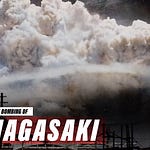The Tsar Bomba, a Soviet nuclear bomb code named “Ivan”, was the most powerful nuclear weapon ever created and tested. The testing of this bomb would be the Soviet’s declaration of nuclear competence to the United States, which held superiority over the USSR in the nuclear weapons race.
In order to drop (and survive) the largest nuclear bomb, the Soviets modified a T-U-95-V bomber for the test.
On 30 October 1961, At 9:30 a.m., a specially modified Tupolev Tu-95V bomber, under the command of Major Andrey Ergorovich Durnovtsev, departed Olenegorsk Air Base carrying 9 crew. The Tu-95 was accompanied by a Tupolev Tu-16 instrumentation ship which would act as a flying laboratory to monitor the blast.
This was the Soviet Union’s 130th nuclear weapons test - a single RDS-220, a three-stage radiation-implosion thermonuclear bomb. The bomb was variously known as “Big Ivan” or “Tsar Bomba” (King of Bombs).
At 11:33 am, 15 kilometers (9 miles) north of the Mityushikha Strait on Novaya Zemlya, from an altitude of 10-thousand 500 meters, the 27-ton bomb was dropped with a parachute. The parachute would allow the aircraft to gain enough distance from the blast to avoid damage.
The bomb fell for 3 minutes and 8 seconds before detonating at 4-thousand meters above Novaya Zemlya. 45 seconds after detonation, the nuclear cloud reached a height of 30 kilometers, spreading outward, reaching a maximum of 95 kilometers wide and 67 kilometers high – well above the stratosphere.
The fireball at detonation reached 8 kilometers wide, however the bomb’s shock wave, bouncing off the earth’s surface, prevented the fireball from reaching the ground. The shock wave circled the globe three times in the atmosphere and similarly in the earth’s crust.
The aircraft that had dropped the bomb was approximately 39 kilometers away for “ground zero” at the time of the explosion. As it continued to fly away from the blast, the shock waves finally caught up to bomber at a distance of 115 kilometers, 8 minutes, 20 seconds after they had released the bomb.
The aircraft dropped a kilometer in altitude because of the shockwave but was able to recover and was not unduly damaged.
Big Ivan had yielded an estimated 57 megatons of energy - the largest nuclear weapon detonation in history. All buildings in the town of Severny, 55 kilometers from Ground Zero, were destroyed. Wooden buildings as far as 200 kilometers were destroyed or heavily damaged. In an analysis of the blast, 97% of the energy yield was produced by fusion, and, relative to the size of the explosion, very little fallout was produced.











Share this post